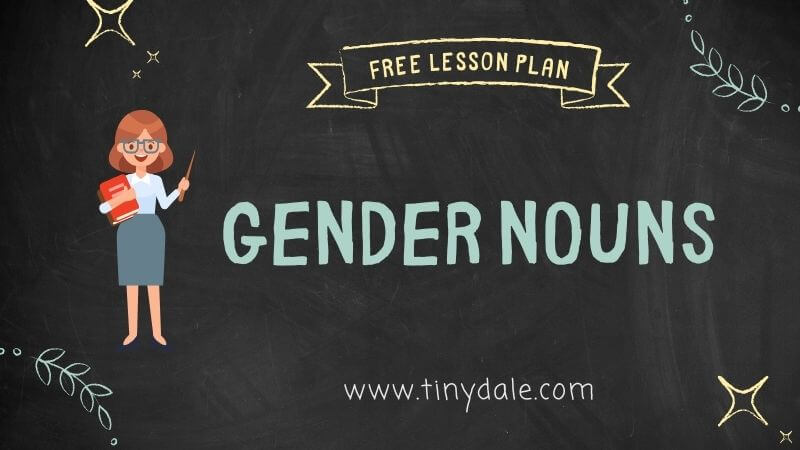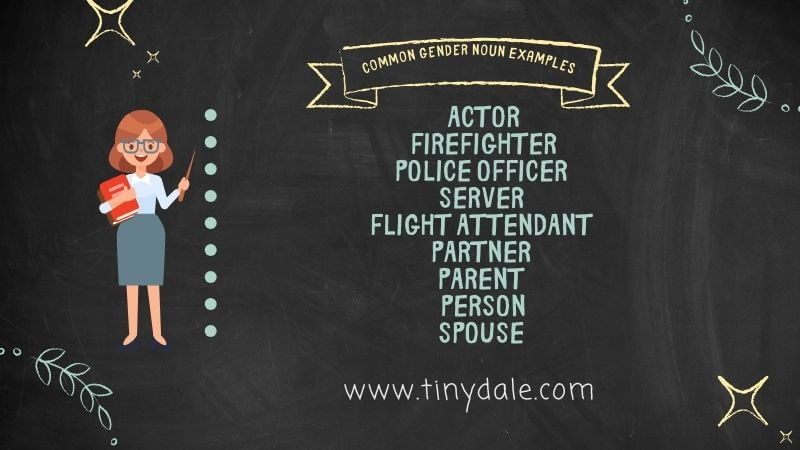Explore the intricacies of gender nouns, a linguistic phenomenon that transcends traditional binary classifications, impacting language, identity, and societal perceptions here! Dive into the evolving landscape of gendered language. Source
Gender Nouns
Gender nouns play a crucial role in language and society. Acknowledging diverse gender identities through gender-neutral language promotes inclusivity and respect.
It challenges traditional norms, reducing bias and discrimination. Embracing this linguistic evolution fosters a more equitable world where everyone can express their identity freely.
As our understanding of gender continues to evolve, so too must our language, reflecting a progressive, inclusive, and empathetic society.
Common Gender Noun Examples
These nouns are words that traditionally refer to specific genders, but evolving language recognizes the importance of gender inclusivity. Here are some examples:
- Actor (instead of actor/actress)
- Firefighter (instead of fireman)
- Police officer (instead of policeman/policewoman)
- Server (instead of waiter/waitress)
- Flight attendant (instead of steward/stewardess)
- Partner (instead of boyfriend/girlfriend or husband/wife)
- Parent (instead of mother/father)
- They/them (as gender-neutral pronouns)
- Person (when a gender-specific term is unnecessary)
- Spouse (instead of husband/wife).
What Is Gender Noun?
In English, gender nouns are typically used to signify whether a noun is masculine, feminine, or neuter.
However, it’s important to note that English is not a language with grammatical gender like some other languages (e.g., Spanish or French).
Instead, English uses them sparingly, mostly for living beings, and their use often reflects traditional social and cultural norms rather than grammatical rules. Here’s a brief overview. Source
- Masculine: These nouns are used to refer to males or things traditionally associated with males. For example, “man,” “boy,” “king,” “uncle,” etc.
- Feminine: These nouns are used to refer to females or things traditionally associated with females. For example, “woman,” “girl,” “queen,” “aunt,” etc.
- Neutral: These nouns do not have a gender association and are used for objects, concepts, or entities that are not living beings. For example, “book,” “table,” “car,” “tree,” etc.
Opposite Gender Nouns
In English, opposite-gender nouns refer to pairs of nouns that represent the different genders (masculine and feminine) for living beings. Here are some examples of opposite-gender nouns:
- Man – Woman: This pair represents the masculine and feminine genders for adult humans.
- Husband – Wife: These nouns represent the masculine and feminine partners in a marriage.
- Father – Mother: These nouns denote the masculine and feminine parents of a child.
- Boy – Girl: This pair signifies the masculine and feminine genders for children or young individuals.
- King – Queen: These nouns represent the male and female rulers of a monarchy.
- Actor – Actress: These terms signify the male and female performers in the entertainment industry.
- Groom – Bride: These nouns represent the male and female individuals getting married.
- Son – Daughter: These words refer to the male and female children of parents.
- Nephew – Niece: This pair signifies the male and female children of one’s sibling.
- Uncle – Aunt: These nouns represent the brothers and sisters of one’s parents.
These opposite-gender nouns are used to distinguish between male and female counterparts in various contexts, such as family relationships, professions, and roles in society.
However, as mentioned earlier, there’s a growing emphasis on using gender-neutral language to promote inclusivity and reduce gender bias in language and communication.
Gender Neutral Nouns
Gender-neutral nouns are words that do not specify a particular gender. They are used to avoid gender-specific language, which can be exclusionary or reinforce gender stereotypes. Gender-neutral language is more inclusive and respectful of diverse gender identities.
Examples of gender-neutral nouns include “actor” instead of “actor/actress,” “firefighter” instead of “fireman,” and “parent” instead of “mother/father.”
Question And Answers
What are gender nouns examples?
Masculine nouns: boy, father, rooster, king, and actor. Feminine nouns girl, mother, hen, queen, and actress.
What are the 4 types of genders?
- Masculine
- feminine
- common
- neuter.
What are the list of all gender nouns?
Some of the list are:
- actor/actress,
- author/authoress,
- bachelor/spinster,
- boy/girl,
- boy scout/girl guide,
- bridegroom/bride,
- brother/sister,
- conductor/conductress,
- count/countess,
- cowboy/cowgirl,
- duke/duchess,
- emperor/duchess,
- father/mother,
- father-in-law/mother-in-law,
- gentleman/lady,
- god/goddess.
What are the 12 nouns of common gender?
- baby
- doctor
- player
- neighbor
- friend
- parent
- anchor
- pupil
- teacher
- cousin
- reporter.
How to define gender?
Gender refers to the characteristics of women, men, girls and boys that are socially constructed. Source
What is gender and its types?
Gender is used to tell whether a noun is male or female. It is of 4 types:
- Masculine
- feminine
- common
- neuter.
What is a common gender noun?
A noun that is used for both the male and female forms of the noun is known as common gender noun.
What is the gender of the tiger?
Masculine gender.
What is the gender of a duck?
Feminine Gender.
Summary!
In conclusion, understanding and embracing these nouns and gender-neutral language fosters inclusivity, challenges stereotypes, and promotes equality. It’s a small change with a significant impact, paving the way for a more equitable future.
Also Read: Possessive Nouns – Meaning And Examples (Free Games)
Tinydale is on YouTube, Click here to subscribe for the latest videos and updates.
Follow Us: Facebook | Instagram | Twitter | Youtube | Pinterest




